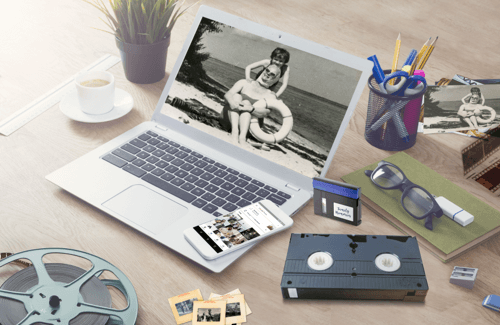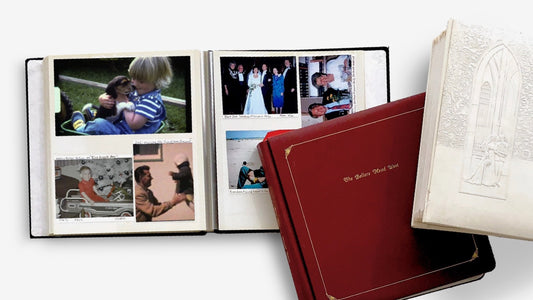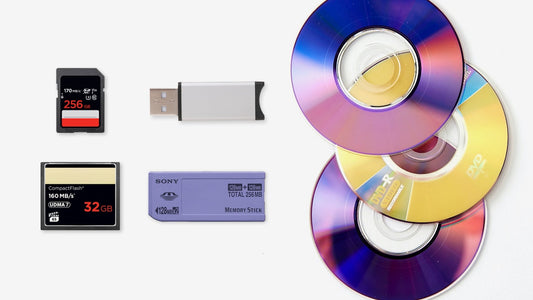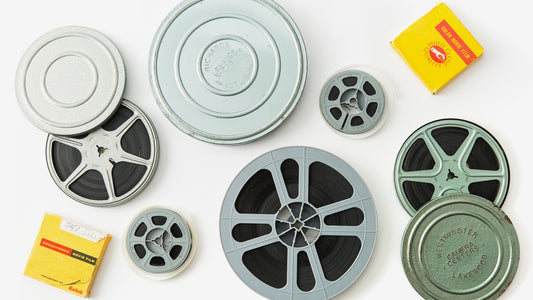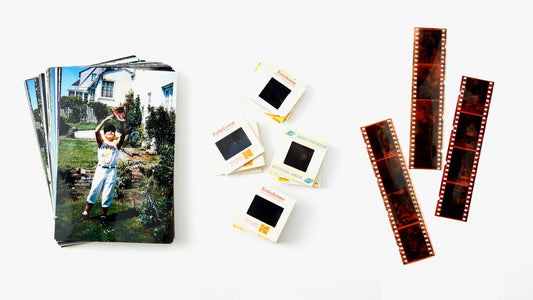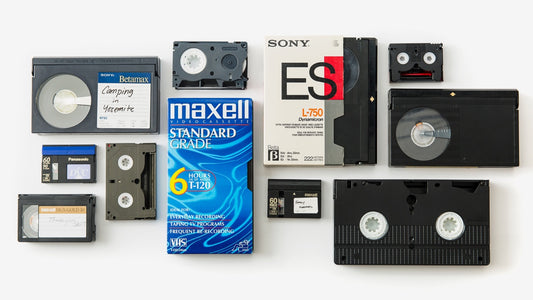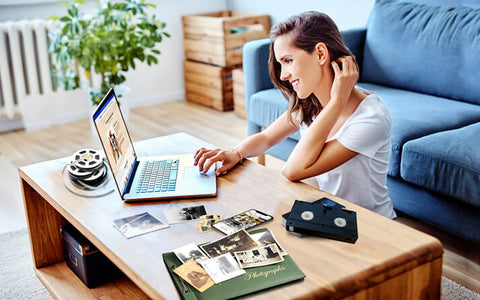Those boxes of VHS tapes in your closet are more than just old plastic; they're time capsules. They hold the birthdays, holidays, and everyday moments you can't get back. But with each passing year, those magnetic tapes fade, and the risk of losing those memories forever grows. The solution is to convert your VHS to digital, creating a permanent, shareable archive of your family's story. It might seem like a big task, but I'm here to help. We'll explore the best ways to do it, from easy professional services to hands-on DIY methods, so you can protect your irreplaceable memories.
Key Takeaways
- Protect your memories by digitizing VHS tapes. VHS is a fragile format. Digitizing ensures your home movies are safe from damage and easily accessible for years to come.
- Choose the right digitization method for your needs. Professional services offer convenience, while DIY methods offer more control. Weigh the pros and cons of each to find the best fit.
- Expand your digital archive beyond VHS. Digitize photos, film reels, and slides to create a complete family history that can be easily shared and enjoyed by future generations.
Why Should You Digitize Your VHS Tapes?
Remember those bulky VHS tapes stacked in your closet? They hold precious memories: birthday parties, graduations, family vacations. But VHS tapes are fragile. They degrade over time, losing picture quality and becoming susceptible to damage from mold, dust, and even temperature fluctuations. Digitizing your VHS tapes safeguards those irreplaceable moments and makes them accessible for years to come. Plus, it frees up valuable storage space!
Think about it: once your tapes are digital, you can easily watch them on your computer, smart TV, or even your phone. Sharing those special moments with family and friends becomes effortless—no more rewinding or worrying about compatibility issues. Digital formats are also much easier to back up, ensuring your memories are safe even if your computer crashes or your phone gets lost. Services like CVS Photo make this process simple and convenient. While digitizing can seem like an investment, especially if you have a large collection, consider the long-term value of preserving your family history.
The Limited Lifespan of VHS Tapes
Those VHS tapes from your childhood might feel timeless, but the physical tapes themselves are anything but. The magnetic tape inside a VHS cassette typically begins to break down after about 15 years. That means home movies from the 80s and 90s are already well past their prime, and their picture and sound quality are likely fading. With each passing year, the risk of losing those memories to decay increases. To make matters worse, digging out an old VCR can sometimes do more harm than good, as aging machines can snag or even erase the fragile tape. The clock is ticking on these memories, making preservation a truly important task.
Understanding Magnetic Tape Degradation
So, what’s actually happening inside the cassette? It’s a process called magnetic tape degradation. Each tape is made of a thin plastic coated with magnetic particles that store the video and audio. Over time, the binder holding these particles together breaks down, and the magnetic signal weakens. This decay usually starts within 10 to 25 years, showing up as fuzzy images, faded colors, and muffled sound. By choosing to transfer your videos to a digital format, you create a stable, high-quality copy that halts this decay, safeguarding your family’s stories for everyone to enjoy with perfect clarity.
The Challenge of Finding Working VCRs
Even if your tapes have miraculously survived the years, you still face another major hurdle: finding a VCR to play them. Since they aren't made anymore, locating one often means a treasure hunt through thrift stores, online marketplaces, or your parents' basement. And finding a VCR is only half the battle; you need one that works properly and won’t risk eating your irreplaceable tapes. This is where digitizing your collection really simplifies things. Once your home movies are converted to digital files, you can watch them on any device you already own—your laptop, smart TV, or phone—making it easy to relive and share those moments without searching for any outdated equipment.
How to Choose a Professional Conversion Service
Key Factors to Consider
Once you’ve decided to use a professional service, the next step is choosing the right one. This decision is a big deal—after all, you’re handing over irreplaceable family memories. Not all digitization companies are created equal, so it’s worth doing a little research to find one you can trust completely. To make a confident choice, you’ll want to look at a few key areas: the convenience of their process, the security measures they have in place to protect your tapes, and their overall reputation and experience in the industry. Thinking through these factors will help you find the perfect partner to preserve your family’s legacy.
Convenience: Mail-In vs. In-Store Drop-Off
You’ll generally find two options for getting your tapes to a digitization service: in-store drop-off or mail-in. Some companies partner with large retail stores where you can leave your tapes. While this might feel convenient, it often means your precious memories are handled by multiple parties before ever reaching the lab. The alternative is a direct mail-in service, which creates a secure and streamlined path to the experts. At YesVideo, we simplify the process by sending you a crush-proof Welcome Kit with a prepaid shipping label. You just pack your tapes and send them directly to our state-of-the-art facility, ensuring they are handled with care from the moment they leave your home.
Security and Tracking Systems
Let's be honest, mailing your only copy of a cherished home movie can feel a bit scary. That’s why top-tier security and tracking are absolutely essential. A trustworthy service will have a robust system in place to monitor your order from start to finish, giving you total peace of mind. Before you commit, find out how they track your media. At YesVideo, we manually process every order at our US-based facility, and we apply a unique barcode to every single tape, film reel, or photo album. This allows us to track your memories by hand throughout the entire digitization journey, so you always know they’re in safe hands.
Customer Reviews and Company Experience
A company’s history and customer feedback speak volumes. Before making your final decision, take some time to read reviews and see what other families are saying about their experience. Look for consistent comments on quality, customer support, and turnaround time. Experience is just as important. A company that has been preserving memories for decades has likely perfected its craft. With over 20 years of experience, YesVideo has helped millions of families safeguard their histories. As the world’s largest and most trusted photo transfer service, we pour that expertise and care into every order we receive.
Comparing the Top VHS to Digital Services
Digitizing your old VHS tapes is easier than ever, thanks to numerous services designed to handle the process. Whether you have a few precious home movies or boxes full of memories, there's a service out there for you. Here are a few popular options to consider:
YesVideo
YesVideo stands out for its commitment to quality and a streamlined process. All orders are handled by hand in the USA, ensuring your precious memories are treated with care. They offer a range of services beyond VHS tapes, including film, photo, and album scanning, making them a one-stop shop for all your digitization needs. You can explore their video transfer services on their website.
Our Handled-with-Care Process
Sending your home movies away requires a lot of trust, and that's something YesVideo takes seriously. What I appreciate most is their commitment to a hands-on approach. Every order is processed by hand by a team of trained technicians right here in the USA. This isn't some automated assembly line; it's a meticulous, personal process designed to protect your one-of-a-kind tapes. From the moment your order arrives, your memories are treated with the respect they deserve. This careful handling provides incredible peace of mind, ensuring your irreplaceable moments are in safe, capable hands as they undergo digitization.
What You Receive from YesVideo
After the transfer is complete, you get your memories back in a format that’s easy to enjoy and share. You can choose to receive your newly digitized videos as a digital download, on a convenient USB drive, or on a classic DVD. This flexibility means you can easily share clips with family on social media or have a physical copy to gift to a loved one. But the service isn't limited to just videotapes. If your collection includes other formats, YesVideo can help you create a complete digital family archive. They also offer film transfer for old 8mm or 16mm reels and photo scanning for loose prints and slides, making it a true one-stop solution for preserving your family's history.
CVS Photo: What to Expect
CVS Photo offers a convenient option for digitizing your old media. With locations across the country, dropping off your tapes is easy. They handle various formats, from VHS and VHS-C to Hi8 and MiniDV. Check out their website for more details on their video transfer process.
Pricing and Turnaround Time
When you use a service like CVS, you can typically expect your finished order to be ready for pickup in about three weeks. While specific pricing isn't always listed upfront on their site, professional conversion services generally charge between $15 and $35 per tape. Keep in mind that there might be additional costs for extras like getting your digital copies on a USB drive or ordering multiple DVDs for family members. It’s a good idea to confirm the total cost before you commit, so you know exactly what to expect when you place your order.
How the Process Works
The process for using a retail drop-off service is designed for convenience. First, you’ll gather all the media you want to digitize, whether it's VHS tapes, film reels, or photos. Next, you place your order online, specifying what you want to convert and how you’d like to receive your digital files. Once your order is placed, you simply package your media and drop it off at the photo department of a participating store. From there, your memories are sent to a processing facility to be digitized, and you’ll be notified when they are ready for pickup.
What You Receive
Once the digitization process is complete, you’ll get all of your original tapes back, so you don't have to worry about losing the physical copies. Alongside your originals, you will receive your new digital memories in the format you selected during your order. Most services offer a choice between a DVD set, a USB thumb drive, or access to your files through a private online gallery. This makes it easy to watch your videos on a TV, computer, or share them with loved ones no matter where they are. It’s a complete package that preserves the old while giving you the new.
Walmart Photo: Is It a Good Option?
Walmart, through a partnership with DVD Walmart, provides VHS digitization services, along with options for film, photos, and slides. This makes it a convenient choice if you're already a regular Walmart shopper. Learn more about their video transfer options on their website.
Pricing and Turnaround Time
When you use a service like CVS, you can typically expect your finished order to be ready for pickup in about three weeks. While specific pricing isn't always listed upfront on their site, professional conversion services generally charge between $15 and $35 per tape. Keep in mind that there might be additional costs for extras like getting your digital copies on a USB drive or ordering multiple DVDs for family members. It’s a good idea to confirm the total cost before you commit, so you know exactly what to expect when you place your order.
How the Process Works
The process for using a retail drop-off service is designed for convenience. First, you’ll gather all the media you want to digitize, whether it's VHS tapes, film reels, or photos. Next, you place your order online, specifying what you want to convert and how you’d like to receive your digital files. Once your order is placed, you simply package your media and drop it off at the photo department of a participating store. From there, your memories are sent to a processing facility to be digitized, and you’ll be notified when they are ready for pickup.
What You Receive
Once the digitization process is complete, you’ll get all of your original tapes back, so you don't have to worry about losing the physical copies. Alongside your originals, you will receive your new digital memories in the format you selected during your order. Most services offer a choice between a DVD set, a USB thumb drive, or access to your files through a private online gallery. This makes it easy to watch your videos on a TV, computer, or share them with loved ones no matter where they are. It’s a complete package that preserves the old while giving you the new.
Costco Digital Transfer: The Details
Costco, in partnership with YesVideo, also offers VHS digitization services to its members. This can be a cost-effective option if you're already a Costco member, potentially offering exclusive deals. A quick online search will reveal comparisons of YesVideo and Costco, helping you decide which service best suits your needs.
Legacybox: How It Works
Legacybox specializes in digitizing a variety of old media formats, including VHS tapes. They provide a dedicated service with various package options to suit different needs and budgets. You can explore their website to learn more about their services.
Pricing and Turnaround Time
Legacybox often structures its pricing around kits, where you choose a box size that accommodates a certain number of items, like tapes, film reels, or photos. The cost is based on the kit you select rather than a per-item fee. It's important to factor in potential extra costs. While the initial kit price is clear, things like shipping and the format of your digital copies, such as a USB drive or DVD set, can add to the final bill. According to industry research, professional conversion services can have shipping costs ranging from $25 to $100, so it's always a good idea to review the full cost before sending your memories off. Turnaround times can also vary, so be sure to check their current estimates if you have a specific deadline in mind.
The Legacybox Kit and Process
The Legacybox process is designed to be straightforward. It starts when they mail you a "Legacybox" kit. This box comes equipped with everything you need to securely pack your media, including instructions, safety barcodes to track each individual tape or photo album, and a pre-paid UPS shipping label for sending it back to them. Once your box arrives at their facility, their team digitizes each item by hand. This hands-on approach ensures your memories are handled with care throughout the conversion. The barcode system allows you to track the progress of your order, giving you peace of mind while your precious items are away from home.
What You Receive
Once the digitization process is complete, Legacybox sends everything back to you. You’ll receive all of your original media, so you don't have to worry about losing your tapes, film, or photos. Alongside your originals, you'll get your newly digitized memories on the format you selected during your order. The options typically include a secure cloud download, a USB thumb drive, or a set of DVDs. This gives you the flexibility to watch, share, and preserve your memories in the way that works best for you and your family, ensuring they are safe and accessible for generations to come.
Walgreens Photo: Another Option
Pricing and Supported Formats
If you’re frequently at your local Walgreens, their photo department offers another convenient drop-off point for your digitization project. They handle the entire conversion process for you, returning your original media once everything is digitized. This is a great option if you prefer handling things in person rather than mailing your precious tapes away. Walgreens can process a wide variety of formats, allowing you to digitize more than just your VHS collection all at once. It simplifies the task of preserving different types of memories, from your wedding video on a VHS-C tape to your childhood photos stored as negatives, by consolidating them into a single project.
Walgreens supports the following formats:
- Videotapes: VHS, VHS-C, Betamax, 8mm, Hi8, Video8, Digital8, MiniDV, and MicroMini
- Movie Film: 8mm, Super 8, and 16mm film reels
- Photos: Prints, slides, and negatives
Their pricing is competitive, starting at $34.99 for each videotape and $29.99 for film reels and photo scanning projects. This straightforward pricing structure helps you estimate the cost of your project upfront. Before you head to the store, it's a good idea to gather all your media and count how many items of each type you have. You can find all the specifics on the official Walgreens Photo page to confirm details and see if their service is the right fit for preserving your memories.
Going DIY: Your VHS to Digital Conversion Toolkit
Want to digitize your VHS tapes yourself? It's totally doable, but it takes time, patience, and the right equipment. This section walks you through everything you need.
Your Hardware Checklist
First, gather your tools. You'll need a few key pieces of hardware to transfer those memories from VHS to a digital format.
VCR Player: Obviously, you'll need a working VCR to play your tapes. Don't worry if you don't have one tucked away in the attic. You can often find VCRs at thrift stores, online marketplaces (like eBay or Facebook Marketplace), or even garage sales.
Capture Device: This is the bridge between your old VCR and your computer. A capture device connects to your VCR and converts the analog VHS signal into a digital format your computer can understand. You have a few options here, from dedicated VHS capture devices to combination VCR-DVD recorder units (which then require ripping the DVD to a digital file). Check out some capture devices on Amazon to get an idea of what's available.
Computer: Finally, you'll need a computer (Mac or PC) to run the software and store the digital files. Video files can be large, so make sure you have a decent amount of hard drive space. An external hard drive is a good investment if you're short on space.
Standalone Capture Devices
If you're looking for a simple, no-fuss way to digitize your tapes, a standalone capture device is a great choice. Think of it as a small, dedicated machine that does one job really well. Devices like the ClearClick Converter 2.0 let you connect your VCR directly to the converter, which then records the video onto an SD card or USB drive. The biggest advantage here is that you don't need a computer or any special software to get the job done. It’s a straightforward, plug-and-play solution perfect for anyone who wants to convert their tapes without getting tangled up in tech complications.
Computer-Based Capture Devices
For those who want a bit more control over the final product, a computer-based capture device is the way to go. Popular options like Elgato or EasyCap are small devices that connect your VCR to your computer's USB port. Using software on your computer, you can record the video as it plays from the tape. This method gives you more flexibility, allowing you to manage file types, choose the video quality, and even do some basic editing once the video is captured. It’s a fantastic option if you’re comfortable with computer software and want to fine-tune your digital memories before saving them.
VCR/DVD Recorder Combos
Remember those VCRs that also had a built-in DVD recorder? They offer another path to digitization. With these combo units, you can record your VHS tape directly onto a blank DVD. Once you have the DVD, the next step is to get that video onto your computer. You can use free software like Handbrake to "rip" the video from the DVD, converting it into a digital file like an MP4. This method is convenient because it creates a physical backup on a DVD before you move to a fully digital format, giving you an extra layer of security for your precious home movies.
Choosing Your Conversion Software
Now for the software side of things. You'll need a program to capture and potentially edit your video.
Capture Software: Some capture devices come bundled with their own software. If yours doesn't, you'll need to find a compatible program. HandBrake is a popular free and open-source option for ripping DVDs, and OBS Studio is another free option that can record directly from your screen. You can also find dedicated video capture software online.
Video Editing Software (Optional): While not strictly required, video editing software can be helpful for cleaning up your digitized videos. You can trim unwanted footage, adjust the brightness and contrast, and even add titles or transitions. iMovie (for Mac) is a user-friendly option, and there are plenty of other free and paid video editors available for both Mac and PC. If you're looking for more advanced options, explore some of the professional video editing software available.
DIY vs. Pro Service: Which Is Right for You?
Digitizing your VHS tapes can feel like a big undertaking. Should you tackle it yourself, or trust a professional service? Both DIY and professional VHS to digital conversion have their pros and cons. Understanding these will help you make the best choice for your family’s treasured memories.
Breaking Down the Costs
One of the first things you’ll likely consider is cost. Professional conversion services typically charge between $7.50 and $34.99 per tape, sometimes more depending on the tape length and any extra services. YesVideo offers a range of VHS digitization services to meet different needs and budgets. DIY might seem cheaper initially, but factor in the cost of a VCR, an analog-to-digital converter, and the value of your time. It can add up quickly.
The Budget for a DIY Project
Going the DIY route can feel like the most budget-friendly option, especially if you already have some of the necessary gear. The main costs come from acquiring the equipment. You'll need a working VCR, which can run anywhere from $30 to over $300 on secondhand markets. Then there's the analog-to-digital converter to connect the VCR to your computer. After that, you have to think about storage. Digital video files are large, so you might need to purchase an external hard drive or pay for extra cloud storage, which can add another $10 to $300 to your total. All in, you should plan for a budget of around $100 to get started with a basic DIY conversion setup.
The Cost of a Professional Service
Professional services offer a straightforward, per-tape pricing model, which makes budgeting simple. Costs typically range from $15 to $35 per tape. While this might seem higher upfront than a DIY project, it includes the use of high-end equipment and the expertise of trained technicians, ensuring a quality transfer. Keep in mind there can be extra costs for shipping or for receiving your digital files on a USB drive or DVD. Services like YesVideo handle every tape with care, providing peace of mind that your memories are in good hands. By using a professional video transfer service, you save yourself the time and potential frustration of troubleshooting old technology, making it a valuable investment for preserving your family’s history.
How Much Time Will It Take?
DIY conversion requires a significant time investment. You'll need to set up the equipment, learn the software, and monitor the conversion process, which can take hours per tape. Plus, there’s a learning curve. You'll need to figure out how to adjust the tracking on your VCR for the best possible quality. If you’re short on time or technical skills, a professional service like YesVideo is a convenient option. We handle everything for you, so you can focus on enjoying your memories, not troubleshooting technical issues.
Time Investment for Professional Services
Choosing a professional service is the ultimate time-saver. Your main job is to gather your tapes and send them off. From there, the experts take over. You don't have to worry about finding a working VCR, untangling cables, or learning new software. Instead of spending hours monitoring each tape's transfer, you can go about your life, confident that your memories are being handled with care. With a service like YesVideo, the entire video transfer process is streamlined for your convenience. You simply pack your media, ship it, and wait for your new digital files and original tapes to be returned to you, ready to enjoy.
Time Investment for DIY Conversion
The DIY route demands a serious time commitment. It’s not just a one-time setup; you have to convert each tape individually. Since the transfer happens in real-time, a three-hour tape will take at least three hours to digitize—and that doesn't include the time spent setting up your equipment, learning the software, or editing the final video. If you have a large collection, this can quickly turn into a project that spans weeks or even months. You'll need to be present to start and stop the recording for each tape and troubleshoot any issues that pop up, like a tape getting chewed or the picture quality flickering.
What Kind of Quality Can You Expect?
Whether you choose DIY or professional conversion, it's important to have realistic quality expectations. VHS tapes aren't known for their pristine resolution. Don't expect perfect, high-definition results. Even with professional equipment, some imperfections are inherent to the original format. Common issues like poor video quality and synchronization problems can occur with either method. If you go the DIY route and encounter sync issues, video editing software can sometimes help, but it adds another layer of complexity. Professional services like YesVideo often include basic quality correction, giving you the best possible version of your original tapes.
Potential Quality from a DIY Setup
When you go the DIY route, the quality of your digital videos is in your hands. The final result depends a lot on the condition of your VCR and the capture device you choose. There's definitely a learning curve involved; you'll need to get comfortable with the software and figure out the best settings for your specific tapes. A big part of this is learning how to adjust the tracking on your VCR to get the clearest possible picture, which can sometimes feel like a bit of an art form. While it's satisfying to manage the whole process yourself, be prepared for some trial and error to get the quality you're hoping for.
Guaranteed Quality from a Professional Service
Opting for a professional service takes the guesswork out of the equation. Companies that specialize in this work use commercial-grade equipment that's far more advanced than what most of us have at home. Their technicians know how to handle delicate tapes and get the most out of them. For instance, a service like YesVideo often includes basic quality correction as part of the process, ensuring you receive the best possible version of your original home movies. This means you can trust that your memories are being preserved with care and expertise, giving you a high-quality digital copy without any of the technical headaches.
How to Convert VHS Tapes: A Step-by-Step Guide
Converting your VHS tapes to digital might seem like a big task, but with the right tools and some patience, it's totally doable. Here’s how to convert VHS to digital, step by step:
Gather your equipment. You'll need a few things: a VCR player, a video capture device to connect your VCR to your computer, RCA cables, and a computer with enough storage space. You'll also need video capture software. Some popular and user-friendly options include Movavi Video Editor Plus and iMovie.
Connect everything. Use the RCA cables (the red, white, and yellow ones) to connect the output of your VCR to the input of your video capture device. Then, connect the capture device to your computer with a USB cable. This setup sends the video signal from your VCR to your computer so you can record it. If you get stuck, this Reddit thread offers helpful visuals for connecting your devices.
Adjust the tracking. Before you hit record, adjust the tracking on your VCR. This often-overlooked step can significantly improve the video quality. A clear picture on your TV screen translates to a clear digital recording.
Start recording. Now for the main event! Play the VHS tape in your VCR and simultaneously start recording using your chosen software. Keep an eye on things to make sure everything is working smoothly. If you run into problems, try different software or double-check your connections. This guide offers solutions to common VHS-to-digital conversion issues.
Save and edit. Once the recording is finished, save the digital file to your computer. You might want to edit the video—trim out any unnecessary bits or enhance the quality. Once you're happy with the final product, save it in your preferred format. If you encounter problems, this article has solutions for common issues during VHS to digital conversion.
Tips for the Best-Quality VHS to Digital Conversion
So, you’ve decided to convert those precious VHS tapes to digital. Excellent! Now, let’s talk about maximizing quality during the transfer process. Whether you’re going DIY or using a professional service like YesVideo, these tips will help you get the best possible results.
How to Prep Your Tapes for Conversion
Before you even begin the conversion, take a moment to prep your VHS tapes. First, check those RCA cable connections and make sure they’re securely plugged into both your VCR and capture device. Loose connections can lead to fuzzy video or audio loss. Next, give the tape heads a good cleaning. Over time, they can accumulate dust and debris, impacting playback quality. A simple head cleaner can make a big difference. Finally, adjust the tracking settings on your VCR. This often-overlooked step can significantly improve the clarity of your digitized videos.
What's the Best File Format for Your Videos?
Picking the right file format is key for preserving video quality and ensuring compatibility across your devices. MP4 is a popular choice due to its wide compatibility and manageable file size. MOV offers excellent quality but can result in larger files. AVI is another option, known for its lossless compression, which preserves the original video quality, but creates very large files. Consider your storage capacity and how you plan to use the videos when making your decision. If you're using a professional service like YesVideo, they can help guide you toward the best format.
Fine-Tuning Your Capture Settings
If you’re converting your tapes yourself, pay close attention to your capture settings. These settings determine the resolution, bitrate, and other factors that influence the final video quality. A higher resolution and bitrate generally result in a better-looking video, but also a larger file size. Experiment to find the balance between quality and file size. Be aware that software can sometimes crash during capture, so saving your progress regularly is wise. If you encounter sync issues after the conversion, video editing software can often fix them.
Troubleshooting Common VHS Conversion Issues
Let's be honest: VHS tapes are old. Even tapes stored in ideal conditions can degrade over time. So, don't be surprised if you run into a few snags during the conversion process. Here's how to tackle some common issues:
How to Handle Damaged Tapes
If your tape has tracking problems (that wobbly, distorted picture), try adjusting the tracking settings on your VCR. Most VCRs have a tracking button or wheel that you can fine-tune. A little adjustment can sometimes make a big difference. If the tape is physically damaged (e.g., mold, tears), consider getting it professionally cleaned or repaired before transferring. YesVideo offers video transfer services that can handle even the most delicate tapes.
Fixing Common Audio Problems
Audio sync issues, where the sound doesn't match the video, can be frustrating. If this happens, video editing software can help you realign the audio and video tracks. Many free and paid video editing programs are available. Also, ensure the driver software for your video capture device is up to date. Outdated drivers can sometimes cause synchronization problems.
How to Fix Poor Video Quality
Before you convert, clean the VHS tape heads on your VCR. A dirty head can significantly impact video quality. If you're still not happy with the quality after cleaning the heads and trying different capture settings, the conversion software itself might be the issue. Experimenting with different software programs can sometimes yield better results. If you're not comfortable troubleshooting these issues yourself, consider using a professional service like YesVideo for your video transfers.
How to Store and Share Your Newly Digitized Videos
After converting your VHS tapes to digital, storing and sharing your new digital videos safely and conveniently is important. Let's explore some options.
Best Cloud Storage for Your Videos
Cloud storage offers a practical solution for storing your digital videos. Services like Google Drive, Dropbox, and Box provide ample space and easy access from any device. Box is known for its unlimited storage options with business plans, a great perk if you have large video files. If you already use Amazon services, Amazon Photos offers 5 GB of free storage, with unlimited storage available for Prime members. Cloud storage not only keeps your videos safe but also simplifies sharing.
Physical Storage: Hard Drives and USBs
If you prefer a tangible backup, external hard drives and USB flash drives are excellent options. These physical storage solutions reliably store large video files without needing internet access. External hard drives, in particular, can offer terabytes of storage, ideal for extensive video collections. Look for a drive with a good reputation for durability and speed to ensure your videos are safe and easily accessible.
How to Share Videos with Family and Friends
Once your videos are digitized and stored, sharing them with friends and family is easy. YouTube and Vimeo are popular choices for uploading and sharing videos publicly or privately. These platforms offer easy sharing and options for editing and enhancing your videos. Social media platforms like Facebook and Instagram also enable quick sharing. Consider creating a private group or album on these platforms to share your memories with select family and friends.
Beyond VHS: Digitizing Other Media Formats
Don’t stop at VHS tapes. You probably have other outdated media formats hiding in boxes and drawers. Digitizing these can truly unlock your family history. Think about it—those old photos, slides, and home movies capture moments you can’t get back. They’re a window into the past, connecting you to family members both present and gone.
Digitizing Camcorder Tapes, Film, and Photos
Beyond VHS tapes, consider digitizing these formats:
- Film reels: 8mm, Super 8, and 16mm film hold irreplaceable family movies. Services like YesVideo’s film transfer option make this process easy. You can also find options at big box stores like CVS, which offers transfer services for various film formats.
- Photos and slides: Digitize printed photos, negatives, and slides to preserve them and make sharing easier. YesVideo’s photo transfer service handles these formats.
- Photo albums: Instead of carefully turning fragile pages, scan your photo albums. YesVideo offers album scanning to create digital copies of your entire album.
- Digital media: Transfer files from old hard drives, USB drives, and memory cards to a modern format or the cloud. Consider YesVideo's digital media transfer service for a hassle-free experience.
- Audio: Don’t forget about cassette tapes and reel-to-reel audio. These often hold important family memories, like recordings of loved ones or special events.
How to Create a Lasting Digital Archive
Once everything is digitized, create a digital archive. This could be a cloud storage service, an external hard drive, or both. A digital archive protects your files from physical damage and makes them accessible from anywhere. It also makes sharing with family a breeze. Imagine emailing your siblings a funny home video from your childhood or posting a slideshow of vintage family photos online. Digitizing your family memories keeps those stories alive for generations to come.
Related Articles
- Best VHS Video to Digital Converters: Top Picks – YesVideo
- VHS to DVD: Top Transfer Services & DIY Guide – YesVideo
Frequently Asked Questions
Why should I digitize my old VHS tapes instead of just keeping them?
VHS tapes degrade over time, leading to a loss of picture and sound quality. Digitizing converts them to a more stable format, preserving your memories for much longer. Plus, digital files are easier to share with family and friends, and take up less physical storage space.
What's the best way to digitize VHS tapes: DIY or professional services?
Both have their pros and cons. DIY is more hands-on and requires specific equipment and software, but gives you complete control. Professional services like YesVideo offer convenience and expertise, handling the entire process for you. The best choice depends on your technical skills, budget, and the number of tapes you need to convert.
What are the most common problems encountered when converting VHS to digital, and how can I fix them?
Common issues include tracking problems (wobbly picture), audio-video synchronization issues, and poor video quality. Tracking problems can often be fixed by adjusting the tracking wheel on your VCR. Audio-video sync issues might require video editing software. Poor video quality can stem from dirty VCR heads, incorrect capture settings, or the inherent limitations of the VHS format itself.
What are the best digital file formats and storage options for my converted videos?
Popular digital video formats include MP4, MOV, and AVI. MP4 offers a good balance of quality and file size, while MOV provides higher quality but larger files. AVI uses lossless compression, preserving maximum quality but creating very large files. For storage, consider cloud services like Google Drive, Dropbox, or Amazon Photos, or physical storage like external hard drives and USB flash drives.
Besides VHS tapes, what other types of media should I consider digitizing to preserve family memories?
Film reels (8mm, Super 8, 16mm), photos and slides, photo albums, old digital media (hard drives, USB drives, memory cards), and audio cassettes or reel-to-reel tapes are all valuable sources of family history that benefit from digitization. Consider these formats when creating your digital archive.





